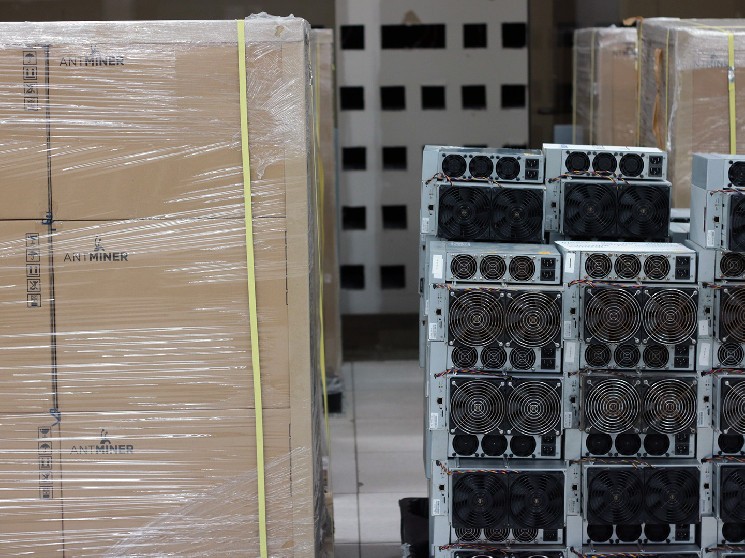Bitcoin Mining Earnings Wrap: Marathon Shares Underperform After New SEC Subpoena

Shares of Marathon Digital (MARA) fell about 12% on Thursday, underperforming other bitcoin mining peers, despite reporting better-than-expected first quarter results.
The company, one of the largest publicly-traded bitcoin miners, said in a filing on Wednesday that it received another subpoena from the U.S. Securities and Exchange Commission (SEC), which is looking into related-party transactions, among other things, that may have violated federal securities law.
Marathon said it will also be increasingly vertically integrating across the bitcoin mining tech stack, “all the way from the mining pool down to the ASIC [application-specific integrated circuits],” CEO Fred Thiel said in a call with investors on Thursday. Marathon is the only major miner to run its own pool.
The miner has so far pursued an asset-light strategy, in which it doesn’t own facilities and infrastructure and operates a lean team. Marathon is not “abandoning” this strategy, Thiel said. It will maintain its “agility” as it diversifies. It will take a more active role in developing facilities, building out technology and innovating in business models.
Marathon’s shares are down on a day when most of the crypto-linked stocks are down as bitcoin price fell about 2%.
Several bitcoin miners posted their first-quarter earnings in the past 24 hours, with Marathon and CleanSpark (CLSK) slightly exceeding analyst expectations and some others setting their sights on new operational targets for the year.
Riot Platforms (RIOT) significantly missed analyst estimates, reporting a net loss per share of $0.33, higher than the expected $0.14.
The Texas miner also missed its target for 12.5 exahash/second (EH/s) of computing power, or hashrate, though this wasn’t a large surprise as the company in February said 17,000 of its mining rigs were offline due to damage from a winter storm.
Meanwhile, Stronghold Digital Mining (SDIG) reported a net loss of $0.65 per share, roughly the same as last year in the same period, $0.66. Its revenue declined by about 25% to $17.3 million relative to the previous quarter.
Stronghold is accelerating its hashrate guidance, expecting to reach 4 EH/s by the end of the third quarter, as opposed to year-end. The miner is also looking into a new revenue stream, selling ash that can be used as fertiliser or be put back into land to help regrow vegetation. Stronghold burns coal refuse to generate the electricity that powers its mining machines, and sells some of that back to the grid.
Halving talk
Some miners started talking about the next halving event; in about a year from now, the reward for successfully mining a bitcoin block will be cut in half.
CleanSpark (CLSK) said that it has acquired all machines to reach its previously stated year-end target for 16 EH/s of computing power. Crucially, these are mostly Bitmain Antminer XPs which are will likely make the firm «one of the most efficient» such that they can take «optimal advantage of halving next year,» said CEO Zach Bradford.
CleanSpark (CLSK) reported a net loss of $0.23 per share from continuing operations, better than the average analyst estimate loss of $0.32 according to FactSet data. The per share loss is roughly half of what it reported in the previous quarter, but worse than the $0.05 profit per share in the same period the year before. CleanSpark uses a fiscal year, so the three months ended March 31 were its second quarter for 2023.
CleanSpark reiterated its target to reach 16 EH/s of computing power.
Despite disappointing earnings and its fair share of operational difficulties, the CEO of Canadian Hut 8 Mining (HUT) Jaime Leverton reassured investors. The miner’s gigantic stack of bitcoin, at 9,133 BTC at the end of Q1, as well as its diversification into high-performance computing hosting, «positively» distinguish the firm «from pureplay digital asset miners» who will have greater exposure to increased competition in the space after the halving, Leverton said.
Hut 8’s revenue from high-performance computing was about a quarter of the total in the first quarter, however its mining revenue was depressed in the quarter due to operational issues.
Read more: Crypto and Bitcoin Miners Rebrand and Diversify to Survive: A Look at Their New Strategies






 Bitcoin
Bitcoin  Ethereum
Ethereum  Tether
Tether  USDC
USDC  Dogecoin
Dogecoin  Cardano
Cardano  TRON
TRON  Chainlink
Chainlink  Stellar
Stellar  LEO Token
LEO Token  Bitcoin Cash
Bitcoin Cash  Hedera
Hedera  Litecoin
Litecoin  Monero
Monero  Dai
Dai  OKB
OKB  Cronos
Cronos  Ethereum Classic
Ethereum Classic  Gate
Gate  VeChain
VeChain  Cosmos Hub
Cosmos Hub  Algorand
Algorand  KuCoin
KuCoin  Stacks
Stacks  Maker
Maker  Theta Network
Theta Network  Zcash
Zcash  Tether Gold
Tether Gold  IOTA
IOTA  Tezos
Tezos  TrueUSD
TrueUSD  NEO
NEO  Polygon
Polygon  Dash
Dash  Decred
Decred  Synthetix Network
Synthetix Network  Zilliqa
Zilliqa  Qtum
Qtum  0x Protocol
0x Protocol  Basic Attention
Basic Attention  Holo
Holo  Siacoin
Siacoin  Ravencoin
Ravencoin  DigiByte
DigiByte  Enjin Coin
Enjin Coin  Status
Status  Ontology
Ontology  Nano
Nano  Hive
Hive  Waves
Waves  Lisk
Lisk  NEM
NEM  Steem
Steem  Pax Dollar
Pax Dollar  Numeraire
Numeraire  BUSD
BUSD  Huobi
Huobi  OMG Network
OMG Network  Bitcoin Gold
Bitcoin Gold  Ren
Ren  Augur
Augur  Bitcoin Diamond
Bitcoin Diamond  HUSD
HUSD